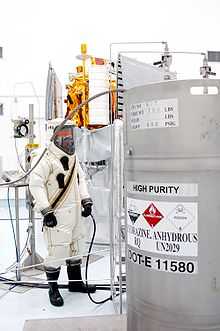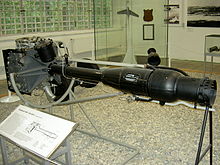Hypergolic propellant

Ahypergolic propellantis arocket propellantcombination used in arocket engine,whose componentsspontaneously ignitewhen they come into contact with each other.
The two propellant components usually consist of afueland anoxidizer.The main advantages of hypergolic propellants are that they can be stored as liquids at room temperature and that engines which are powered by them are easy to ignite reliably and repeatedly. Common hypergolic propellants are difficult to handle due to their extremetoxicityorcorrosiveness.
In contemporary usage, the terms "hypergol" and "hypergolic propellant" usually mean the most common such propellant combination:dinitrogen tetroxideplushydrazine.[1]
History[edit]
In 1935,Hellmuth Walterdiscovered thathydrazine hydratewas hypergolic withhigh-test peroxideof 80–83%. He was probably the first to discover this phenomenon, and set to work developing a fuel. Prof. Otto Lutz assisted theWalter Companywith the development ofC-Stoffwhich contained 30% hydrazine hydrate, 57%methanol,and 13% water, and spontaneously ignited with high strengthhydrogen peroxide.[2]: 13 BMW developed engines burning a hypergolic mix of nitric acid with various combinations of amines, xylidines andanilines.[3]
Hypergolic propellants were discovered independently, for the second time, in the U.S. byGALCITand Navy Annapolis researchers in 1940. They developed engines powered by aniline andred fuming nitric acid(RFNA).[4]Robert Goddard,Reaction Motors,andCurtiss-Wrightworked on aniline/nitric acid engines in the early 1940s, for small missiles and jet assisted take-off (JATO). The project resulted in the successful assisted take off of severalMartin PBMand PBY bombers, but the project was disliked because of the toxic properties of both fuel and oxidizer, as well as the highfreezing pointof aniline. The second problem was eventually solved by the addition of small quantities offurfuryl alcoholto the aniline.[2]: 22–23

In Germany from the mid-1930s throughWorld War II,rocket propellants were broadly classed asmonergols,hypergols,non-hypergolsandlithergols.The endingergolis a combination ofGreekergonor work, and Latinoleumor oil, later influenced by the chemical suffix-olfromalcohol.[Note 1]Monergols weremonopropellants,while non-hypergols werebipropellantswhich required external ignition, and lithergols were solid/liquid hybrids. Hypergolic propellants (or at least hypergolic ignition) were far less prone tohard startsthan electric or pyrotechnic ignition. The "hypergole" terminology was coined by Dr. Wolfgang Nöggerath, at the Technical University ofBrunswick,Germany.[5]
The only rocket-powered fighter ever deployed was theMesserschmitt Me 163BKomet.The Komet had aHWK 109-509,a rocket motor which consumed methanol/hydrazine as fuel and high test peroxideT-Stoffas oxidizer. The hypergolic rocket motor had the advantage of fast climb and quick-hitting tactics at the cost of being very volatile and capable of exploding with any degree of inattention. Other proposed combat rocket fighters like theHeinkelJuliaand reconnaissance aircraft like theDFS 228were meant to use the Walter 509 series of rocket motors, but besides the Me 163, only theBachem Ba 349Nattervertical launch expendable fighter was ever flight-tested with the Walter rocket propulsion system as its primary sustaining thrust system for military-purpose aircraft.
The earliestballistic missiles,such as the SovietR-7that launchedSputnik 1and the U.S.AtlasandTitan-1,usedkeroseneandliquid oxygen.Although they are preferred in space launchers, the difficulties of storing acryogenlike liquid oxygen in a missile that had to be kept launch ready for months or years at a time led to a switch to hypergolic propellants in the U.S.Titan IIand in most Soviet ICBMs such as theR-36.But the difficulties of such corrosive and toxic materials, including injury-causing leaks and the explosion of a Titan-II in its silo,[6]led to their near universal replacement withsolid-fuelboosters, first in Westernsubmarine-launched ballistic missilesand then in land-based U.S. and Soviet ICBMs.[2]: 47
TheApollo Lunar Module,used in theMoon landings,employed hypergolic fuels in both the descent and ascent rocket engines. TheApollo spacecraftused the same combination for theService Propulsion System.Those spacecraft and theSpace Shuttle(among others) used hypergolic propellants for theirreaction control systems.
The trend among western space launch agencies is away from large hypergolic rocket engines and toward hydrogen/oxygen engines with higher performance.Ariane1 through 4, with their hypergolicfirst and second stages(and optional hypergolic boosters on the Ariane 3 and 4) have been retired and replaced with the Ariane 5, which uses a first stage fueled by liquid hydrogen and liquid oxygen. The Titan II, III and IV, with their hypergolic first and second stages, have also been retired. Hypergolic propellants are still widely used in upper stages when multiple burn-coast periods are required, and inlaunch escape systems.
Characteristics[edit]

Advantages[edit]
Hypergolically-fueled rocket engines are usually simple and reliable because they need no ignition system. Although larger hypergolic engines in some launch vehicles useturbopumps,most hypergolic engines are pressure-fed. A gas, usuallyhelium,is fed to the propellant tanks under pressure through a series ofcheckandsafety valves.The propellants in turn flow through control valves into the combustion chamber; there, their instant contact ignition prevents a mixture of unreacted propellants from accumulating and then igniting in a potentially catastrophichard start.
As hypergolic rockets do not need an ignition system, they can fire any number of times by simply opening and closing the propellant valves until the propellants are exhausted and are therefore uniquely suited for spacecraft maneuvering and well suited, though not uniquely so, as upper stages of such space launchers as theDelta IIandAriane 5,which must perform more than one burn. Restartable non-hypergolic rocket engines nevertheless exist, notably the cryogenic (oxygen/hydrogen)RL-10on theCentaurand theJ-2on theSaturn V.TheRP-1/LOXMerlinon theFalcon 9can also be restarted.[7]
The most common hypergolic fuels,hydrazine,monomethylhydrazineandunsymmetrical dimethylhydrazine,and oxidizer,nitrogen tetroxide,are all liquid at ordinary temperatures and pressures. They are therefore sometimes calledstorable liquid propellants.They are suitable for use in spacecraft missions lasting many years. Thecryogenityofliquid hydrogenandliquid oxygenhas so far limited their practical use to space launch vehicles where they need to be stored only briefly.[8]As the largest issue with the usage of cryogenic propellants in interplanetary space is boil-off, which is largely dependent onthe scaleof spacecraft, for larger craft such asStarshipthis is less of an issue.
Another advantage of hypergolic propellants is their high density compared to cryogenic propellants.LOXhas a density of 1.14 g/ml, while on the other hand, hypergolic oxidizers such asnitric acidornitrogen tetroxidehave a density of 1.55 g/ml and 1.45 g/ml respectively.LH2fuel offers extremely high performance, yet its density only warrants its usage in the largest of rocket stages, while mixtures ofhydrazineandUDMHhave a density at least ten times higher.[9]This is of great importance inspace probes,as the higher propellant density allows the size of their propellant tank to be reduced significantly, which in turn allows the probe to fit within a smallerpayload fairing.
Disadvantages[edit]
Relative to their mass, traditional hypergolic propellants possess a lowercalorific valuethan cryogenic propellant combinations likeLH2/LOXorLCH4/LOX.[10]A launch vehicle that uses hypergolic propellant must therefore carry a greater mass of fuel than one that uses these cryogenic fuels.
Thecorrosivity,toxicity,andcarcinogenicityof traditional hypergolics necessitate expensive safety precautions.[11][12]Failure to follow adequate safety procedures with an exceptionally dangerous UDMH-nitric acid propellant mixture nicknamed"Devil's Venom",for example, resulted in the deadliest rocketry accident in history, theNedelin catastrophe.[13]
Hypergolic combinations[edit]
Common[edit]
Common hypergolic propellant combinations include:[14]
- Aerozine 50+nitrogen tetroxide(NTO) – widely used in historical American rockets, including theTitan II;all engines in theApollo Lunar Module.Aerozine 50is a mixture of 50%UDMHand 50% straighthydrazine(N2H4).[2]: 45
- Monomethylhydrazine(MMH) +nitrogen tetroxide(NTO) – smaller engines and reaction control thrusters:Apollo command and service moduleRCS,[15]Space ShuttleOMSandRCS;[16]Ariane 5EPS;[17]Dracothrusters used by theSpaceX Dragonspacecraft.[18]
- Triethylborane/triethylaluminium(TEA-TEB) +liquid oxygen– used during the ignition process of some rocket engines that use liquid oxygen, used by theSpaceX Merlin Engine FamilyandRocketdyne F-1.
- Unsymmetrical dimethylhydrazine(UDMH) +nitrogen tetroxide(NTO) – frequently used byRoscosmos,such as in theProton (rocket family),and supplied by them to France for the Ariane 1 first and second stages (replaced withUH 25);ISROrockets usingVikas engine.[19]
Less common or obsolete[edit]
Less-common or obsolete hypergolic propellants include:
- Aniline+nitric acid(unstable, explosive), used in theWAC Corporal[20]
- Aniline+hydrogen peroxide(dust-sensitive, explosive)
- Furfuryl alcohol+IRFNA(orred fuming nitric acid) –Copenhagen SuborbitalsSPECTRA Engine[21][2]: 27
- Furfuryl alcohol+WFNA(orwhite fuming nitric acid)[2]: 27
- Hydrazine+nitric acid(toxic but stable), abandoned due to lack of reliable ignition. No engine with this combination ever went into mass production.[22]
- Kerosene+ (high-test peroxide+ catalyst) –Gamma,with the peroxide first decomposed by a catalyst. Coldhydrogen peroxideandkeroseneare not hypergolic, but concentrated hydrogen peroxide (referred to as high-test peroxide or HTP) run over a catalyst produces free oxygen and steam at over 700 °C (1,300 °F) which is hypergolic with kerosene.[23]
- Tonka(TG-02, approx. 50%triethylamineand 50%xylidine) typically oxidized withnitric acidor its anhydrousnitric oxidederivatives (AK-2x group in the Soviet Union) e.g.AK-20F(80% HNO3and 20% N2O4withinhibitor).[2]: 14–15, 116
- T-Stoff(stabilized >80% peroxide) +C-Stoff(methanol, hydrazine, water, catalyst) –Messerschmitt Me 163World War II German rocket fighter aircraft, for itsWalter 109-509Aengine.[2]: 13
- Turpentine+IRFNA(flown in French Diamant A first-stage)[24]
- UDMH+IRFNA–MGM-52 Lancemissile system,[25]AgenaandAbleUpper Stages, Isayev-built maneuvering engines.[26]
Proposed, remain unflown[edit]
- Chlorine trifluoride(ClF3) + all known fuels – Briefly considered as an oxidizer given its high hypergolicity with all standard fuels, but ultimately abandoned in the 70s due to the difficulty of handling the substance safely.Chlorine trifluorideis known to burn concrete and gravel.[2]: 74 Chlorine pentafluoride(ClF5) presents the same hazards, but offers higherspecific impulsethan ClF3.
- Pentaborane(9)and diborane +nitrogen tetroxide–Pentaborane(9),a so-calledZip fuel,was studied by Soviet Rocket ScientistV. P. Glushkofor usage in combination withnitrogen tetroxidein theRD-270Mrocket engine. This propellant combination would have yielded a significant increase in performance, but was ultimately given up due to toxicity concerns.[27]
- Tetramethylethylenediamine+IRFNA– A sightly less toxic alternative toHydrazineand its derivatives.
Related technology[edit]
Pyrophoricsubstances, which ignite spontaneously in the presence of air, are also sometimes used as rocket fuels themselves or to ignite other fuels. For example a mixture oftriethylboraneandtriethylaluminium(which are both separately and even more so together pyrophoric), was used for engine starts in theSR-71 Blackbirdand in theF-1engines on theSaturn Vrocket and is used in theMerlinengines on theSpaceXFalcon 9rockets.
Notes[edit]
- ^"-ergol",Oxford English Dictionary
References[edit]
- Citations
- ^Melof, Brian M.; Grubelich, Mark C. (2000-11-15)."Investigation of Hypergolic Fuels with Hydrogen Peroxide".3rd International Hydrogen Peroxide Propulsion Conference.OSTI767866.
- ^abcdefghiClark, John D.(1972).Ignition! An Informal History of Liquid Rocket Propellants(PDF).Rutgers University Press.ISBN978-0-8135-0725-5.Archived(PDF)from the original on 10 July 2022.
- ^Lutz, O. (1957). "BMW Developments". In Benecke, T. H.; Quick, A.W.; Schulz, W. (eds.).History of German Guided Missiles Development (Guided Missiles Seminar. 1956. Munich).Advisory Group for Aerospace Research and Development-AG-20. Appelhans. p. 420.
- ^Sutton, G. P. (2006).History of Liquid Propellant Rocket Engines.Library of flight. American Institute of Aeronautics and Astronautics.ISBN978-1-56347-649-5.
- ^Botho, Stüwe (1998),Peenemünde West: Die Erprobungsstelle der Luftwaffe für geheime Fernlenkwaffen und deren Entwicklungsgeschichte[Peenemünde West: The Luftwaffe's test center for secret guided missiles and the history of their development] (in German), Peene Münde West: Weltbildverlag, p. 220,ISBN9783828902947
- ^Schlosser, Eric (2013).Command and control: nuclear weapons, the Damascus Accident, and the illusion of safety.New York, NY: The Penguin Press.ISBN978-1-59420-227-8.
- ^"SpaceX".SpaceX.Retrieved2021-12-29.
- ^"Fuel Propellants - Storable, and Hypergolic vs. Ignitable by Mike Schooley".Archivedfrom the original on 24 July 2021.
- ^"PROPERTIES OF ROCKET PROPELLANTS".braeunig.us.Archivedfrom the original on 26 May 2022.
- ^Linstrom, Peter (2021).NIST Chemistry WebBook.NIST Standard Reference Database Number 69. NIST Office of Data and Informatics.doi:10.18434/T4D303.
- ^A Summary of NASA and USAF Hypergolic Propellant Related Spills and Firesat theInternet Archive
- ^"Toxic Propellant Hazards"onYouTube
- ^The Nedelin Catastrophe, Part 1,28 October 2014,archivedfrom the original on 15 November 2014
- ^"ROCKET PROPELLANTS".braeunig.us.
- ^Apollo 11 Mission Report - Performance of the Command and Service Module Reaction Control System(PDF).NASA - Lyndon B. Johnson Space Center. December 1971. pp. 4, 8. Archived fromthe original(PDF)on 12 July 2022.
- ^T.A., Heppenheimer (2002).Development of the Shuttle, 1972–1981 - Volume 2..Smithsonian Institution Press.ISBN1-58834-009-0.
- ^"Space Launch Report: Ariane 5 Data Sheet".Archived from the original on February 2, 2013.
{{cite web}}:CS1 maint: unfit URL (link) - ^"SpaceX Updates".SpaceX.2007-12-10. Archived fromthe originalon January 4, 2011.Retrieved2010-02-03.
- ^"ISRO tests Vikas engine".The Hindu.2014-03-23. Archived fromthe originalon 2014-03-23.Retrieved2019-07-29.
- ^"WAC Corporal Sounding Rocket".Archivedfrom the original on 7 January 2022.
- ^"Project SPECTRA - Experimental evaluation of a Liquid storable propellant"(PDF).Archived fromthe original(PDF)on 4 November 2013.
- ^"Nitric acid/Hydrazine".Astronautix.RetrievedJanuary 13,2023.
- ^"High Test Peroxide"(pdf).RetrievedJuly 11,2014.
- ^"European space-rocket liquid-propellant engines".Archivedfrom the original on 23 July 2021.
- ^"P8E-9".Archivedfrom the original on 12 May 2022.
- ^"Nitric Acid/UDMH".Archivedfrom the original on 1 July 2022.
- ^Astronautix:RD-270Archived2009-04-30 at theWayback Machine.
- Bibliography
- Clark, John(1972).Ignition! An Informal History of Liquid Rocket Propellants(PDF).New Brunswick, New Jersey: Rutgers University Press.ISBN0-8135-0725-1.Archived(PDF)from the original on 10 July 2022.
- Modern Engineering for Design of Liquid-Propellant Rocket Engines,Huzel & Huang, pub. AIAA, 1992.ISBN1-56347-013-6.
- History of Liquid Propellant Rocket Engines,G. Sutton, pub. AIAA 2005.ISBN1-56347-649-5.
